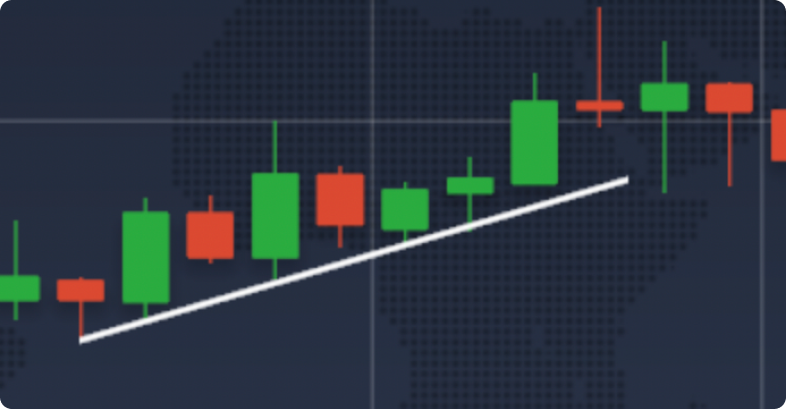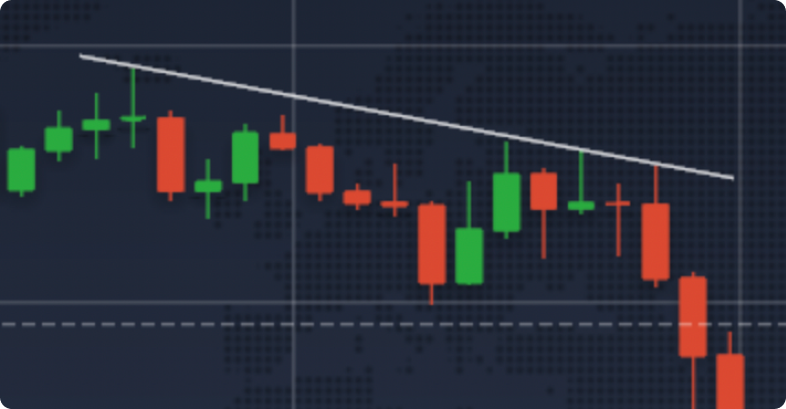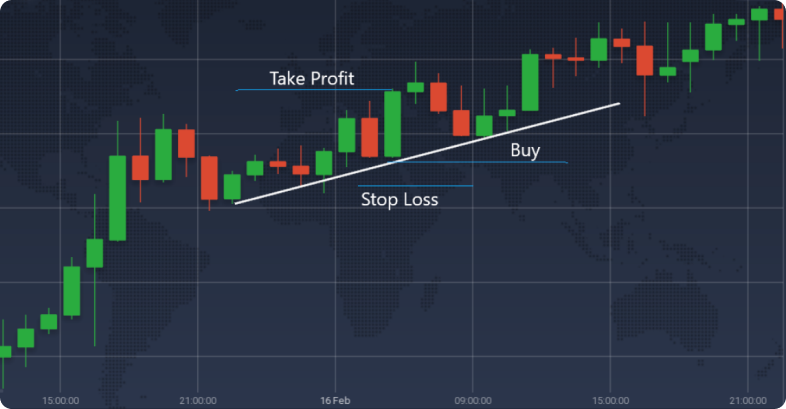The Secret of Trend Lines in Trading: A Comprehensive Guide for Traders


Trend lines, acting as the diagonal counterpart to parallel support and resistance levels, confine chart movements by reflecting the direction of price movements. Their slanted nature and ability to echo price directions make them pivotal in helping traders discern the current market trend, essentially serving as a visual representation of the market’s sentiment.
For those unfamiliar with our discussions on trends, it’s crucial to understand that a trend signifies the prevailing direction of price movement. It forms the basis for market participants’ strategies, guiding decisions on asset transactions. The direction of an asset’s price movement influences the choice of strategy, including whether to initiate long or short positions. The market recognizes three primary trends:
Price volatility across various time frames can obscure the prevailing trend. Trend lines, by connecting points to draw a trend, offer a solution to this ambiguity. They not only facilitate the identification of a trend’s direction but also assess its strength and the likelihood of continuation or reversal. Drawing trend lines involves connecting two significant points – the lowest or highest over a given period, forming a line that serves as a visual guide to the trend’s trajectory.
In essence, trend lines are a fundamental tool in technical analysis, enabling traders to make informed decisions by providing insights into the long-term trend, validating trend lines, and identifying potential entry and exit points. Whether the trend reaches the trend line or breaks through it, these lines offer valuable signals for assessing the overall trend and making strategic trading decisions.
Drawing trend lines mirrors the process of marking support and resistance levels on a chart, utilizing price extremes – specifically, the lowest and highest points over a designated period. In the context of a bullish trend, the trend line, or upward trend line, is strategically positioned beneath the chart to connect lows, forming a line that indicates an ascending trajectory. Conversely, for a bearish trend, the trend line is placed above the chart, connecting highs and suggesting a descending price movement.
To construct a trend line in a bullish market scenario, one would follow these steps:
This method, while straightforward, is instrumental in confirming the trend and establishing potential entry and exit points based on the slope of the trend line and its interaction with price movements.

For bearish trends, maximum points are used, but the overall method remains the same.

Trend lines are usually plotted on candlestick charts. There are two approaches to this – using shadows or bodies. In practice, there’s no significant difference between them, so either can be used. The key is to consistently stick to the chosen method.
Trendlines and channels are pivotal tools in technical analysis, providing traders with insights into market trends and potential reversal points. Understanding the relationship between these tools can significantly enhance trading strategies, especially when it comes to identifying optimal entry and exit points.
For assessing the reliability of trend lines, it’s essential to understand validation techniques that can determine their strength and predictive value. A crucial method involves examining the number of touches or points of contact a trend line has with the price. Generally, a trend line is considered more reliable and significant if it has been touched or approached by the price at least three times, indicating a strong level of support or resistance along that line. Another aspect to consider is the duration the trend line has been in play; longer-lasting trend lines are viewed as more substantial due to their ability to withstand various market conditions over time.
Moreover, the angle of the trend line can offer insights into the trend’s sustainability. Extremely steep trend lines may indicate overextended markets that could be prone to rapid reversals, whereas more moderate slopes are typically sustainable and indicative of a stable trend. Additionally, the volume of trading during the touches to the trend line can serve as a validation tool; increasing volume on touches in the direction of the trend suggests strong market agreement with the trend line’s path.
Implementing these criteria and methods allows traders to critically evaluate the reliability of trend lines, enhancing their decision-making process in forming trading strategies. This nuanced approach to validation ensures that traders can effectively sift through potential false signals, focusing their efforts on trend lines that offer a robust framework for navigating market movements.
Trading with trend lines involves a nuanced understanding of how they interact with market dynamics.
Firstly, the strength of a trend is often gauged by the number of extreme points a trend line intersects. The more points it crosses, the more entrenched the trend is considered to be, reducing the chances of a sudden shift in direction.
Secondly, trend lines serve dual purposes: they can either be utilized as independent indicators or be paired with support and resistance levels to enhance trading strategies. When used in tandem with support and resistance, the ideal moment to enter a trade is typically when the price action touches a trend line that aligns with these levels. Alternatively, a trend line breach might signal an opportune time to initiate a trade, based on the premise that such a breach could herald the beginning of a new trend direction. For instance, in a bullish scenario, if the market’s chart breaches a supporting trend line, suggesting a downward price movement, it might indicate a transition from a bullish to a bearish trend.
There are two primary strategies for trading with trend lines:
In essence, trading with trend lines requires a blend of technical analysis, patience, and strategic planning to navigate the markets effectively.

Trend lines serve as a fundamental and straightforward instrument in technical analysis, offering guidance through intricate market scenarios and signaling opportune times for initiating or concluding trades. Their ability to connect significant price points and outline the market’s directional momentum makes them invaluable for traders seeking to make informed decisions. By understanding the dynamics of trend lines, including their formation, breaches, and the significance of their slopes, traders can better anticipate market movements and strategize accordingly. This utility underscores the importance of mastering trend line analysis as a means to enhance trading efficacy and profitability in the stock market.